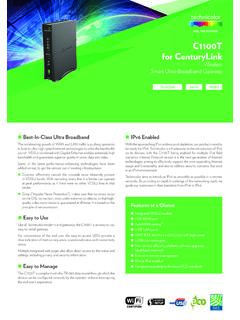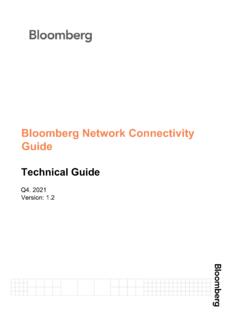Transcription of TR-069 – A Crash Course - UNH InterOperability Laboratory
1 1 2009, University of New Hampshire InterOperability LaboratoryTR-069 A Crash CourseUniversity of New HampshireInteroperability Laboratory20092 Why TR-069 ? TR-069 is the document number of the technical report, defined by the Broadband Forum, that specifies the cpe wan management protocol , CWMP 3 Terms XML TheeXtensibleMarkup Language SOAP The Simple Object Access protocol ; an XML based specification for performing application function calls between web app components CPE customer premises equipment, or the device that is being managed; may include Integrated Gateways (IGD), Set-top-boxes (STB), Network Attached Storage (NAS), etc. ACS Auto-Configuration Server, performs the management of the CPE. Generally, operated by an ISP and plugs into their Operational or Billing Support Systems (OSS/BSS) Data Model a set of objects defined for the management of a particular kind of CPE, usually defined in a companion TechnicalReport by the Broadband Forum RPC Remote Procedure Call.
2 A use of SOAP that allows two applications to make procedure calls on each TR-069 CWMP Currently Amendment 2, which is Defines protocol , message structure, session rules, andRPCs Annexes deal with NAT traversal and association ofgatwaysto LAN devices TR-106 XML Schema definition and common objects for Device Data Models TR-098 Device Data Model for Internet Gateway Devices The slew of otherWTsandPDs Redefining generic device model, adding proxy functions, StackCPE/ACS management ApplicationRPC MethodsSOAPHTTPSSL/TLSTCP/IP7 XML eXtensibleMarkup Language Used to describeinformation Through SOAP, allows client/server application transactions through Remote Procedure Calls (RPCs)8 XML Schema, Namespaces A particular use of XML is described in a Schema (.xsd) Schemas inherit, like in other languages, through namespaces 9TR-069 XML Schemas RPC Schema (contained in TR-069 document, section ) CWMP Data Model Schema (TR-106) The Data Models arexmldocuments that are schema-like , but describe the objects and parameters used for a particular TR-069 use Model Example TR-143 (Performance Test Objects and Parameters)11 SOAP The Simple Object Access protocol Is just XML, defined in a schema, that describes how to convey information between peers.
3 RPC (Remote Procedure Call) is one application of SOAP that: Describes how to convey methods and their arguments to be invoked on the peer Describes how the response should look Describes how to convey fault information CWMP uses RPC application of SOAP for faults, call/response format, message ID12 Message Structure<soapenv:Envelopexmlns:soap=" "xmlns:xsd=" "xmlns:cwmp="urn:dslforum-org:cwmp-1-0"xmlns:soapenv=" "xmlns:xsi=" "> <soapenv:Header> <cwmp:IDsoapenv:mustUnderstand="1">1323392</cwmp:ID> </soapenv:Header> <soapenv:Body> <cwmp:SetParameterValues> <ParameterListsoap:arrayType="cwmp:ParameterValueStruct[1]"> <ParameterValueStruct> <Name> </Name> <Valuexsi:type="xsd:string"> </Value> </ParameterValueStruct> </ParameterList> <ParameterKey>1323392</ParameterKey> </cwmp:SetParameterValues> </soapenv:Body> </soapenv:Envelope>The SOAP envelope tag.
4 It contains, as attributes, the namespace references that the later tags will draw from. This one draws from the Schema of Schemas , the Broadband Forum (when created, it was the DSL Forum, and has been maintained for backwards compatibility) CWMP Schema, and the SOAP SOAP Header, in CWMP, contains transaction information. In this case, it contains the CWMP message ID, which is used by the system to associate calls and responses. Note the use of the namespace cwmp:ID it is saying use the ID data type defined in thecwmpnamespace in the envelope attributes, above. The SOAP Body contains the actual RPC call or response, as well as all of the arguments they contain. In this case, we see aSetParameterValuesRPC. This is a procedure that exists on the CPE, that is called by the ACS, to which the CPE will respond.
5 As you can see, the RPC uses the SOAP definition of an array, further specified by thecwmpnamespace to refer to a ParameterValueStruct . [1] is the size of the array. TheParameterValueStructis a name/value pair, and the XML tags represent connectionSSL initiationHTTP postHTTP responseInformrequestInformresponseHTTP postGetParameterValuesresponseHTTP responseSetParameterValuesrequestHTTP postSetParameterValuesresponseClose connectionHTTP responseHTTP postHTTP responseGetParameterValuesrequestThe CPE initiates the connection. The CPE is always the initiator, though the ACS can make a Connection Request to stimulate the CPE to initiate a connection. The underlying protocols establish a connection. TR-069 is almost always performed over Secure Socket Layer (SSL), unless for testing , the CPE is always the initiator of the session.
6 It begins EVERY new session by making an Inform RPC on the ACS, with arguments that include the reason for the session and a list of parameters it must inform the ACS ACS sends anInformReponseto the CPE for the Inform RPC. This means the Inform RPC is the CPE indicated that it has no moreRPCsto make on the ACS. This is indicated by an empty HTTP post. This post may happen at any time, since the TCP session is still this example, the ACS then makes aGetParameterValuesRPC on the CPE sends aGetParameterValuesResponse, containing the information the ACS wants. This means theGetParameterValuesRPC is ACS makes any other Remote Procedure Calls that it needs to make on the CPE during this particular CWMP session. Here, it is , the ACS sends an empty HTTP response to indicate it has no moreRPCsto make on the CPE.
7 Since the CPE has already done the same thing, this ends the CWMP the session closed, the underlying protocols close their connections and the session is successfully terminated .What does a session look like?14 Connection Request While the CPE always initiates a session, the ACS can stimulate it to do so It does this by issuing a Connection Request A Connection Request is a simpleHTTPG etmade on the CPE at an arbitrary URL/port set by the CPE The CPE tells the ACS what its CR URL is during the Inform15 Authentication TR-069 requires the use of HTTP basic, HTTP digest, or Certificate based authentication Authentication occurs in both directions The CPE authenticates theACS sConnection Requests The ACS authenticates theCPE ssession initiation16 Remote Procedure CallsList in CWMP Methods GetRPCM ethods SetParameterValues GetParameterValues GetParameterNames SetParameterAttributes GetParameterAttributes AddObject DeleteObject Reboot Download Upload FactoryReset GetQueuedTransfers GetAllQueuedTransfers ScheduleInform SetVouchers GetOptionsACS Methods GetRPCM ethods Inform TransferComplete AutonomousTransferComplete RequestDownload Kicked17 The Inform The Inform RPC is a an RPC made on the ACS by the CPE It MUST be called FIRST in every session It contains the reason(s) for the session (an Event)
8 Contains a list of parameters that are required by the Data Model to be included ( Forced Inform ) Contains parameters that the ACS set to be notified upon changes. The ACS completes the RPC by sending <soap:Body> <cwmp:Inform> <DeviceId> <Manufacturer>SomeCompany</Manufacturer> <OUI>000A73</OUI> <ProductClass>IGD</ProductClass> <SerialNumber>123456789</SerialNumber> </DeviceId> <Event soap-enc:arrayType="cwmp:EventStruct[1]"> <EventStruct> <EventCode>2 PERIODIC</EventCode> <CommandKey/> </EventStruct> </Event> <MaxEnvelopes>1</MaxEnvelopes> <CurrentTime>2008-10-23T01:49:14+00:00</CurrentTime> <RetryCount>0</RetryCount> <ParameterListsoap-enc:arrayType="cwmp:ParameterValueStruct[6]"> <ParameterValueStruct> <Name> </Name> <Valuexsi:type="xsd:string" /> </ParameterValueStruct> <ParameterValueStruct> <Name> </Name> <Valuexsi:type="xsd:string"> </Value> </ParameterValueStruct> <ParameterValueStruct> <Name> </Name> <Valuexsi:type="xsd.
9 String"> </Value> </ParameterValueStruct> <ParameterValueStruct> <Name> </Name> <Valuexsi:type="xsd:string"> :1234/</Value> </ParameterValueStruct> <ParameterValueStruct> <Name> </Name> <Valuexsi:type="xsd:string">null</Value> </ParameterValueStruct> <ParameterValueStruct> <Name> </Name> <Valuexsi:type="xsd:string"> </Value> </ParameterValueStruct> </ParameterList> </cwmp:Inform> </soap:Body>Example Inform<soapenv:Envelopexmlns:soap=" "xmlns:xsd=" "xmlns:cwmp="urn:dslforum-org:cwmp-1-0"xmlns:soapenv=" "xmlns:xsi=" "> <soapenv:Header> <cwmp:IDsoapenv:mustUnderstand="1">1</cwmp:ID> </soapenv:Header> <soapenv:Body> <cwmp:InformResponse> <MaxEnvelopes>1</MaxEnvelopes> </cwmp:InformResponse> </soapenv:Body> </soapenv:Envelope>19 Events<Event soap-enc:arrayType="cwmp:EventStruct[1]"> <EventStruct> <EventCode>2 PERIODIC</EventCode> <CommandKey/> </EventStruct> </Event> The Inform event array contains a list of one or more pre-defined reasons for the session being initiated.
10 8 DIAGNOSTICS COMPLETE 9 REQUEST DOWNLOAD 10 AUTONOMOUS TRANSFER COMPLETE M Reboot M Scheduled Inform M Download M Upload Vendor Specific Functions and 0 BOOTSTRAP 1 BOOT 2 PERIODIC 3 SCHEDULED 4 VALUE CHANGE 5 KICKED 6 CONNECTION REQUEST 7 TRANSFER COMPLETE 20 Why does a CPE start a session?<-- 0 BOOTSTRAP <-- 1 BOOT <-- 2 PERIODIC <-- 3 SCHEDULED When it first contacts this ACSWhen it rebootsWhen its periodic inform interval is metWhen an inform was scheduledWhen a parameter set for notification has changedWhen it is asked to by the ACSWhen it has completed an upload or download and is going to call TransferComplete When it has completed diagnosticsThe CPE wants to request a download<-- 4 VALUE CHANGED <-- 6 CONNECTION REQUEST <-- 7 TRANSFER COMPLETE <-- 10 AUTONOMOUS TRANSFER COMPLETE <-- 8 DIAGNOSTICS COMPLETE <-- 9 REQUEST DOWNLOAD 21 What about these M Events?











